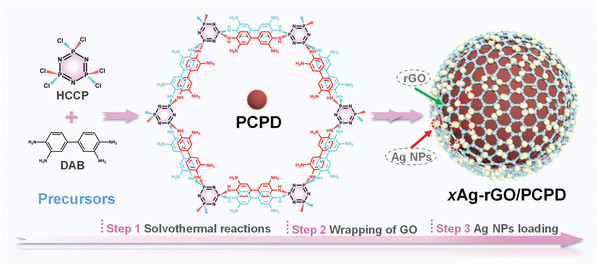Optimizing Adsorption-Redox Sites and Charge Transfer of Ternary Polymer Photocatalyst with P―N Linkage for CO2 Conversion Coupled with Antibiotics Removal
Mengmeng Wang1, Guping Zhang1, Shihong Dong2, Najun Li1, Qingfeng Xu1, Hua Li1, Jianmei Lu1(路建美)*, Dongyun Chen1(陈冬赟)*
1Collaborative Innovation Center of Suzhou Nano Science and TechnologyCollege of Chemistry Chemical Engineering and Materials Science, Soochow University199 Ren’ai Road, Suzhou 215123, P. R. China
2Suzhou Shijing Technology Co., Ltd.58 Jinrui Road, Suzhou 215137, China
Adv. Funct. Mater. 2024, 34, 2406516
Abstract: The rational design of bifunctional photocatalysts with high adsorption and enrichment characteristics and excellent photocatalytic redox activity is an effective way to address environmental pollution and energy shortage crisis. In this study, cyclophosphazene-derived porous organic polymer (PCPD) microspheres with P─N linkage are coated with graphene oxide (GO) and loaded with Ag0 nanoparticles (NPs) to prepare covalently bonded xAg-rGO/PCPD composites. The catalyst with the highest specific surface area (denoted as 2.5Ag-rGO/PCPD) shows excellent adsorption capacity for fluoroquinolone antibiotics, removing 96.2% of ciprofloxacin (CIP) through adsorption. By applying the catalyst with the best photocatalytic redox activity (denoted as 5Ag-rGO/PCPD), 82.97% of refractory sulfonamide antibiotics are removed through adsorption-degradation, and 635.3 µmol g−1 of CO and 162.3 µmol g−1 of CH4 are generated as products of CO2 photoreduction alone. Among the co-catalytic systems, the highest CO yield of 9.16 µmol g−1 is obtained by coupling CO2 reduction with levofloxacin (LVX) degradation to harness the electron-donating power of the pollutant molecule. This study is expected to provide useful guidance for the rational design of bifunctional photocatalysts.

链接://onlinelibrary.wiley.com/doi/10.1002/adfm.202406516